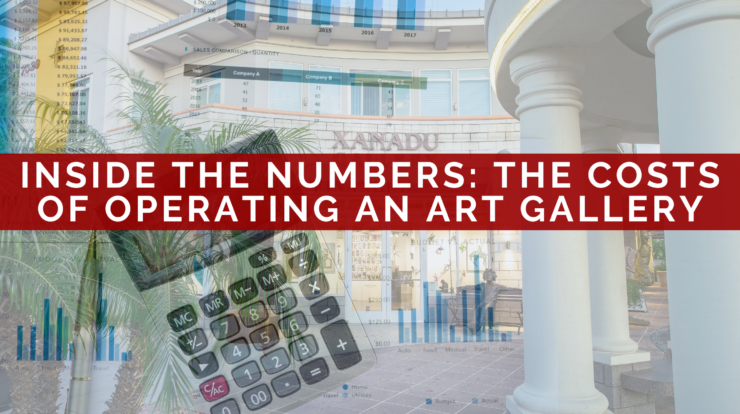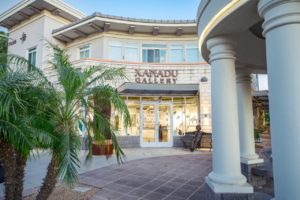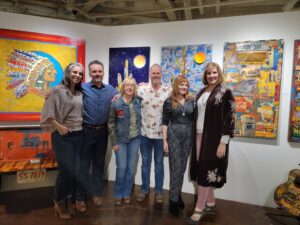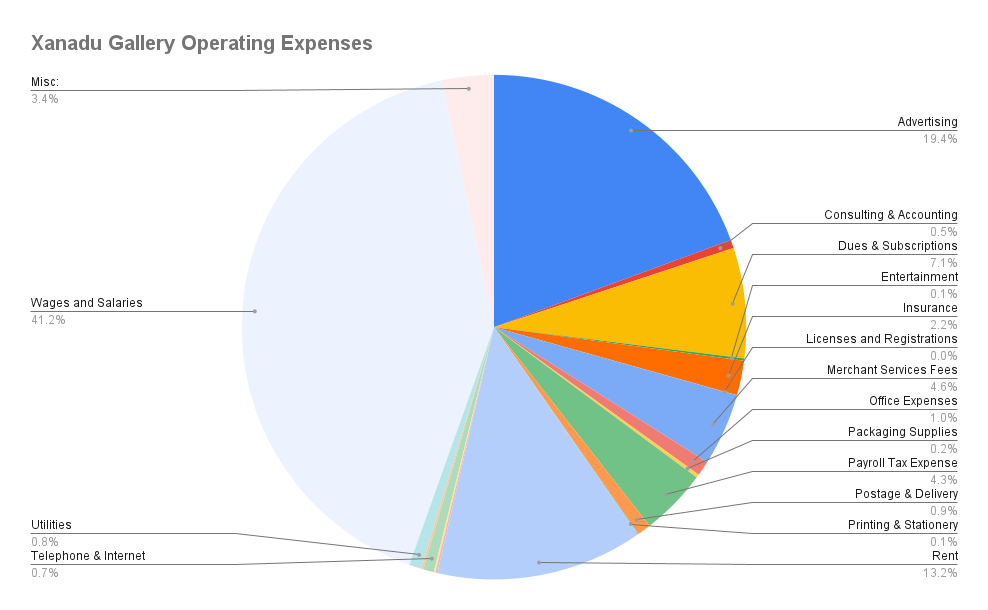
In today’s blog post, I’m lifting the veil on a topic often shrouded in mystery within the art world: gallery expenses. As an art gallery owner deeply committed to transparency and empowering artists, I believe it’s crucial to shed light on how galleries allocate their resources. By sharing a detailed breakdown of my gallery’s operating expenses, I aim to provide artists with valuable insights into the inner workings of gallery operations.
It’s important to note that while I’ll be offering a glimpse into my own gallery’s financial landscape, every gallery operates uniquely. From overhead costs to marketing expenditures, each gallery allocates its resources based on its specific goals, priorities, and business model.
My hope is that by demystifying gallery spending, artists can gain a clearer understanding of the economic dynamics at play in the art world. Armed with this knowledge, artists can make more informed decisions about their own careers and better navigate their relationships with galleries.
Let’s dive into the numbers and explore the various facets of gallery expenses together. Please note that the expenses are listed alphabetically, not in order of importance or scale.
Advertising
Advertising, comprising 19.4% of our total expenditures, reflects a strategic allocation of resources that has undergone significant evolution over the past 18 months. During this period, we’ve made substantial investments, both in terms of time and financial resources, into social media marketing initiatives. This deliberate focus on leveraging the power of platforms like Instagram, and Facebook has yielded remarkable results, profoundly impacting our sales trajectory (you can see some of the results in this post).
We prioritize social media marketing because it allows us to directly engage with our audience, build meaningful connections, and drive conversions. Unlike traditional advertising, social media provides precise metrics to measure campaign effectiveness.
Additionally, we produce a bi-monthly catalog tailored to resonate with collectors and new homeowners. This tangible medium complements our digital efforts, reinforcing our brand and expanding our sales reach.
In contrast, our spending on magazine advertising has declined over the years to the point where we are no longer running magazine ads. The challenge of measuring magazine ads’ results led us to shift focus. Unlike social media and our catalog, traditional ads lacked transparent analytics for measuring results.
Consulting & Accounting
 Accounting and consulting expenses, accounting for just 0.5% of our spending, are vital for ensuring the financial health and compliance of our gallery. Although we handle bookkeeping internally, the expertise of a Certified Public Accountant (CPA) is indispensable for navigating complex tax obligations.
Accounting and consulting expenses, accounting for just 0.5% of our spending, are vital for ensuring the financial health and compliance of our gallery. Although we handle bookkeeping internally, the expertise of a Certified Public Accountant (CPA) is indispensable for navigating complex tax obligations.
A proficient CPA meticulously maintains our financial records and ensures compliance with regulations. Their strategic advice helps us optimize tax strategies, minimize liabilities, and take advantage of available incentives in the ever-changing tax landscape.
Despite their small share of expenses, accounting and consulting services are crucial for our gallery’s financial well-being. By relying on skilled professionals, we can focus on our core business activities with confidence in our financial management.
Dues & Subscriptions
Dues and subscriptions, which make up 7.1% of our total expenses, is an investment in vital tools and services that ensure our gallery operates smoothly. Shopify, a major component of this investment, not only processes our in-store purchases but also takes care of our online sales. It acts as the powerhouse behind both our physical and digital storefronts.
Beyond Shopify, we utilize Google Workspace for our communication and document needs, Todoist to keep our tasks in check, and Adobe Creative Cloud for our design projects. Even though Adobe remains indispensable, we’ve been gravitating towards Canva for its simplicity and ease of use for our design needs.
These tools are critical in helping us maintain order, communicate clearly, and produce stunning visuals that highlight our art collection. They form the core of our business, enabling us to efficiently and effectively support our customers and artists.
Entertainment
Our spending on entertainment is minimal, barely 0.1% of our overall expenses, yet it plays a crucial role. This budget mainly goes towards hosting lunches or dinners that allow our customers to meet and interact with artists. These events are more than just meals; they’re an opportunity for us to build connections and offer unforgettable moments that enhance the experience of visiting our gallery.
These get-togethers are a chance for our visitors to chat with artists, learn about their artistic journey, and develop a deeper appreciation for the art we display. Our goal with these interactions is to enrich the overall gallery visit and build strong, lasting bonds with our clients.
Though the cost of entertainment might seem small in the grand scheme of things, its impact on customer engagement and satisfaction cannot be quantified. This spending reflects our dedication to excellent service and our effort to create a lively and inviting atmosphere in our gallery.
Insurance
Insurance constitutes 2.2% of our total expenditures, a vital investment in safeguarding our gallery against unforeseen risks and potential liabilities. This allocation became even more apparent in 2020 when our space experienced a major flooding incident. While we were incredibly fortunate that none of our artwork suffered damage, the flooding necessitated several weeks of closure for repairs.
During this challenging period, our insurance coverage proved invaluable, providing essential support for the loss of business incurred during our temporary closure. This incident underscored the critical role that insurance plays in mitigating the financial impact of unexpected events and ensuring the resilience of our gallery operations.
By maintaining comprehensive insurance coverage, we not only protect our physical assets but also safeguard the continuity of our business in the face of adversity. It’s a proactive measure that underscores our commitment to prudent risk management and the long-term sustainability of our gallery endeavors.
Licenses and Registrations
Licenses and registrations barely make a dent in our expenditures, not even comprising 0.01% of our total expenses. While this may seem negligible, it’s still a necessary expense that ensures we can continue operating legally and without interruption. Keeping our registrations current is a basic requirement to maintain compliance with regulations and uphold the legitimacy of our gallery business. Though small, this expense is essential for the smooth functioning and ongoing legitimacy of our operations.
Merchant Services Fees
Merchant service fees represent a significant 4.6% of our operating expenses, reflecting the cost of accepting credit card payments. While it’s admittedly painful to shoulder these fees, the reality is that the vast majority of our customers prefer to pay with credit cards. Despite comprising only 2-3% of each transaction’s value, these fees accumulate to nearly 5% of our total operating costs, excluding artist commissions.
Despite the financial sting, investing in merchant service fees is a necessary expense to facilitate smooth and convenient transactions for our customers. By accommodating their preferred payment method, we not only enhance their shopping experience but also streamline our sales process, ultimately driving revenue and sustaining our business operations.
Misc
Miscellaneous expenses comprise 3.4% of our operating costs and encompass a diverse range of hard-to-categorize expenditures. This includes items such as show catering, mileage reimbursements for client deliveries, some income tax expenses, and various other miscellaneous costs essential to our day-to-day operations.
Office Expenses
Office expenses, comprising 1% of our expenditures, cover the fundamental supplies essential for our daily operations. This includes basic necessities like paper, printing cartridges, shipping labels, pens, and batteries. While these items may seem mundane, they are the backbone of our administrative tasks, ensuring smooth workflow and operational efficiency. Investing in these essentials is vital for maintaining the functionality and productivity of our gallery, underscoring their importance despite their mundane nature.
Packaging Supplies
While a significant portion of our packaging needs are outsourced, we still handle some in-house, necessitating a steady supply of boxes, cardboard, bubble wrap, foam, and packing peanuts. Despite representing just 0.2% of our operating expenses, ensuring we have an adequate inventory of these materials is crucial for fulfilling orders and safeguarding the integrity of artworks during transit.
Payroll Tax Expense
In addition to compensating our staff with wages, we also incur payroll taxes as part of the cost of employing personnel. These payroll taxes, amounting to 4.3% of our total expenditures, represent our contribution to government-mandated programs and services associated with employment. While sometimes overlooked, these taxes are a necessary obligation that ensures compliance with regulations and supports various social welfare programs.
Postage & Delivery
Postage and delivery expenses constitute 0.9% of our total expenditures. While a significant portion of our artwork delivery costs are covered by our Shopify subscription, this category encompasses additional postage expenses for mailing artist payments, client correspondence, and various other shipping and delivery needs. From ensuring timely payments to artists to facilitating seamless communication with clients, these postage and delivery expenses play a crucial role in maintaining the operational efficiency and professionalism of our gallery.
Printing & Stationery
Printing and stationery expenses represent a minimal 0.1% of our total expenditures. This category encompasses essential items such as thank-you cards and staff business cards. While seemingly small, these materials play a significant role in enhancing customer appreciation and professional communication within our gallery. By investing in printing and stationery, we ensure that every interaction with our clients and stakeholders reflects our commitment to quality and attention to detail.
Rent
 Rent is one of our most significant expenses, accounting for 13.2% of our ongoing expenditures. This substantial allocation underscores the critical importance of location for a gallery like ours. Situated in the heart of the arts district in a major art market, our gallery’s location is paramount to our success. While the cost of rent may be high, it reflects our commitment to being strategically positioned within a vibrant and dynamic artistic community. This investment ensures that we can attract a steady flow of art enthusiasts and collectors, ultimately driving foot traffic, engagement, and sales within our gallery space.
Rent is one of our most significant expenses, accounting for 13.2% of our ongoing expenditures. This substantial allocation underscores the critical importance of location for a gallery like ours. Situated in the heart of the arts district in a major art market, our gallery’s location is paramount to our success. While the cost of rent may be high, it reflects our commitment to being strategically positioned within a vibrant and dynamic artistic community. This investment ensures that we can attract a steady flow of art enthusiasts and collectors, ultimately driving foot traffic, engagement, and sales within our gallery space.
Telephone & Internet
Telephone and internet expenses comprise 0.7% of our total expenditures, enabling essential communication channels with our customers and artists. These services play a crucial role in maintaining seamless connectivity and facilitating effective communication within our gallery operations. Whether it’s coordinating with artists for upcoming exhibitions or providing responsive customer support, reliable telephone and internet services are indispensable in ensuring smooth and efficient interactions. Despite their relatively modest share of our expenses, investing in these communication tools is essential for fostering strong relationships and driving success within the competitive art market.
Utilities
Likewise, utilities represent 0.8% of our total expenditures and are absolutely essential. We rely on these services to keep the lights on and the air conditioner running, particularly during our long, hot summers. Maintaining a comfortable and well-lit environment is vital for creating an inviting space where artwork can be showcased and appreciated by our visitors. Despite their relatively small percentage of our expenses, utilities play a fundamental role in ensuring the functionality and ambiance of our gallery, contributing to the overall experience and success of our exhibitions and events.
Wages and Salaries

Wages and salaries represent our largest expense, accounting for 41.2% of our total expenditures. This significant investment underscores the paramount importance we place on our exceptional staff, who are unequivocally our most valuable asset. Their dedication, expertise, and commitment are the driving force behind our gallery’s success, shaping the customer experience, fostering relationships with artists, and ensuring the smooth operation of our day-to-day activities. By prioritizing our team members and investing in their professional growth and well-being, we strengthen the foundation of our gallery and position ourselves for continued excellence in the art market.
Did you Find this Breakdown Interesting? Any Surprises?
In summary, running a gallery involves significant expenses, with profit margins typically ranging from 10-17% of total revenue. Were there any surprises for you in my breakdown of expenses? Feel free to share your thoughts or questions in the comments below. I’ll respond to provide insights and clarity on the financial aspects of gallery operations.

You highlighted the importance of your location in the arts district. Could you share how the location impacts your operating costs and overall revenue generation?
As they say in the real estate business, “location, location, location!” A gallery will typically pay substantially more than the typical retail lease rates (or spend more on the purchase of a building, if the gallery owns its space) to be located in an established gallery district. The premium is often worth it if the area draws a higher volume of potential art buyers. A prime location in a well-established market will often allow the gallery to spend less on advertising in the long run because the buyers are already there.
Thank you so much for sharing. It is a valuable information
Very interesting, thought- provoking and transparent post. Thank you for opening artists’ eye to those commision percentages.
Jason I think what you have discussed concerning expenses is well within what I have observed in many small businesses (I.e) less than a billion in sales. It’s not easy to be a small business owner and in fact it takes a team which you have acknowledged. Good work.
having operated galleries globally i can concur that the general % noted are common to most galleries. The staff component is often higher and the rent dependant upon location can be astronomical. The best gallery locations can run into the millions per annum. There is no practical way for galleries to exist therefore with low quality, low value works to sell. It is a long term committment that must be maintained despite fluctuations in the economies and personal events. NOT FOR THE LIGHT OF HEART
From a professional artist’s side of the equation I really appreciate your transparency, Jason. Understanding these expenditures actually makes the 40 – 50% commission most galleries require feel less painful. Thanks.
Thanks so much for this article.
As well as being an artist, I have a background in accounting and taxes. You provided an excellent concise explanation of your expenses and what goes into running a gallery. Thank you.
So interesting! What a reward to work with beauty, even with crazy expense.
Most artists, me included have found a spot in their home to ply their trade. Thanks for the article because it gives a little insight into the gallery/artist relationship and answers many artists questions about whey the gallery should make a little money off your sales. I noted that merchant fees were a pretty big expense. I’ve been taking credit cards since the mid 90’s. When I first started taking them i struggled whether I should try and recoup the fees but in the long run I found that the increase is sales warranted the fees charged.
Appears that you run a very well managed business. Expenses are tightly controlled to a winning formula. Impressive…Congrats!
Thank you! This is very helpful to understanding the gallery business. Relatively new to selling my art, understanding the costs incurred by galleries help me to better understand the going commission rates. I am interested in understanding how an artist should use this knowledge as a consideration when pricing original art!
This is huge! Thank you.
I do nnot have a mind for this that is consistent. When I feel pressured, I tend to over-think and consult all sorts of “how tos” which only bog me down.
So, you have turned a big page for me. Thank you for your willoingness to show how you make it work.
What I’ve done is make a spreadsheet with your data in it and then an adjacenmt section where I can put my equivalent expense data. Where there is no equivalence there’s a blank cell. If I have something you don’t have, I add it to the bottim witha b lank cell on your side.
You’re better ghan a hundred how tos because you’re still here and ghriving after decades.
Literally, not a day goes by that I don’t think at least once, “I wonder how Jason would see this.”
Thank you for posting. It is very interesting to learn about all the expenses related to your gallery. You are always so kind to post articles to help all artists understand the industry!